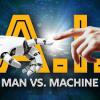
Breaking News
6.8 SPC vs. 300 Blackout: Powering Up the AR Platform
 Autism Study By McCullough Foundation Begins New Era of Free Scientific Inquiry
Autism Study By McCullough Foundation Begins New Era of Free Scientific Inquiry
 REVOLUTION DAY 8: Libertarians JOIN The Revolution
REVOLUTION DAY 8: Libertarians JOIN The Revolution
 US Government and Westinghouse $80bn Nuclear Reactor Deal
US Government and Westinghouse $80bn Nuclear Reactor Deal
Top Tech News
 Graphene Dream Becomes a Reality as Miracle Material Enters Production for Better Chips, Batteries
Graphene Dream Becomes a Reality as Miracle Material Enters Production for Better Chips, Batteries
 Virtual Fencing May Allow Thousands More Cattle to Be Ranched on Land Rather Than in Barns
Virtual Fencing May Allow Thousands More Cattle to Be Ranched on Land Rather Than in Barns
 Prominent Personalities Sign Letter Seeking Ban On 'Development Of Superintelligence'
Prominent Personalities Sign Letter Seeking Ban On 'Development Of Superintelligence'
 Why 'Mirror Life' Is Causing Some Genetic Scientists To Freak Out
Why 'Mirror Life' Is Causing Some Genetic Scientists To Freak Out
 Retina e-paper promises screens 'visually indistinguishable from reality'
Retina e-paper promises screens 'visually indistinguishable from reality'
 Scientists baffled as interstellar visitor appears to reverse thrust before vanishing behind the sun
Scientists baffled as interstellar visitor appears to reverse thrust before vanishing behind the sun
 Future of Satellite of Direct to Cellphone
Future of Satellite of Direct to Cellphone
 Amazon goes nuclear with new modular reactor plant
Amazon goes nuclear with new modular reactor plant
 China Is Making 800-Mile EV Batteries. Here's Why America Can't Have Them
China Is Making 800-Mile EV Batteries. Here's Why America Can't Have Them
Libertarians Want to Make New Hampshire a Flying Car Mecca

Hopes for the flying car soared in January, when one manufacturer, Woburn, Massachusetts-based Terrafugia, attained a long-awaited industry first: a Federal Aviation Authority airworthiness certificate for its Transition, a "roadable aircraft" — a winged, gas-powered, wheeled vehicle that can be both driven and flown. Suddenly the aerial sedan, first popularized in the 1960s cartoon The Jetsons, needed only U.S. Department of Transportation approval before it could be let loose on America's highways and flyways. Terrafugia hailed a "major accomplishment." Champagne corks flew.
But in mid-February, Terrafugia, which is owned by China's Zhejiang Geely Holding Group, quietly laid off 43 employees — almost half of its Massachusetts workforce. Kevin Colburn, vice president and general manager of Terrafugia, which was started in 2006 by MIT grads, says the company is now focused on a new endeavor that is "not in flying cars."
Terrafugia's plummet to Earth should come as little surprise. The roadable aircraft has been on a wobbly trajectory since its inception in 1917, when an enterprising motorcycle builder, Glenn Curtiss, slapped some wings on what resembled a Model T and made an attempt, alas bootless, to take flight. For more than a century, the mass-produced flying car has been an American miracle earnestly promised to hit the market in months. In recent years, hundreds of well-heeled futurists have made reservations to buy a $300,000-plus flying car from Terrafugia and have inked similar orders from its two largest competitors, Samson Sky of Oregon and Pal-V of the Netherlands.

 China Innovates: Transforming Sand into Paper
China Innovates: Transforming Sand into Paper

